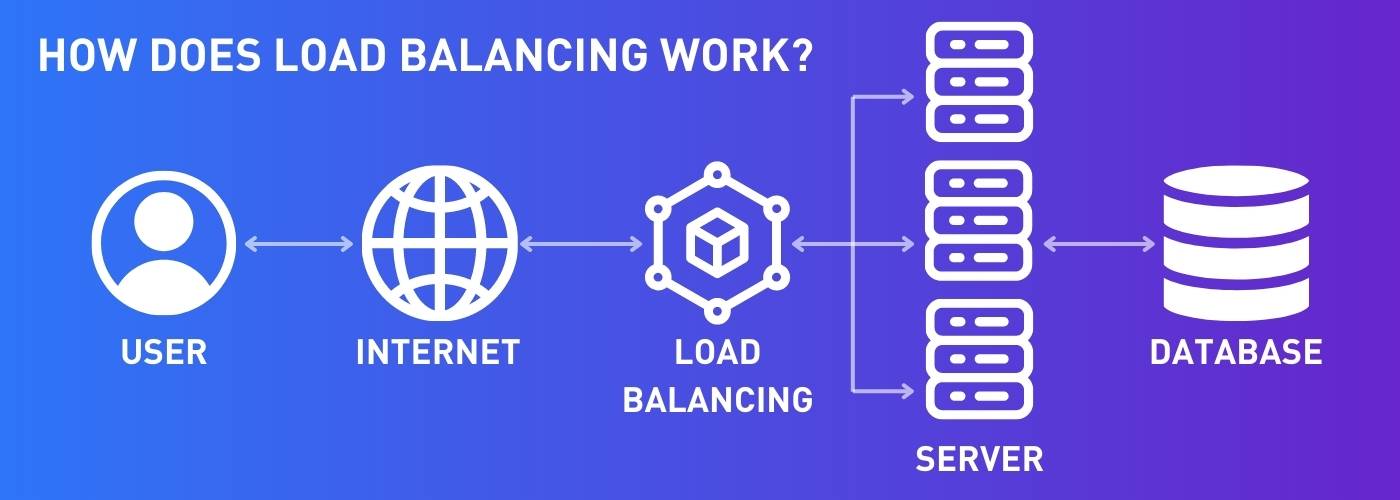Imagine you are trying to access a popular website, but all you see is an error message indicating that the server is overloaded. Frustrating, right? This scenario highlights the critical role of load balancing in today’s digital age. In this article, we’ll explore load balancing and unravel how it works behind the scenes to enable smooth and efficient user experiences on websites and applications.
What Is Load Balancing?

This not only improves the overall response time of the application but also enhances its availability by reducing the risk of server failures or downtime.
One key benefit of load balancing is scalability. By spreading the workload across multiple servers, an organization can handle an increased number of concurrent users without any degradation in performance.
Load balancers intelligently allocate resources based on factors like server capacity, network latency, and current traffic patterns to provide an optimal user experience.
Another advantage of load balancing is fault tolerance. In case one server fails, other healthy servers are available to seamlessly pick up the workload and ensure uninterrupted service for users. This redundancy drastically reduces downtime and improves overall system resilience.
Overall, load balancing plays a vital role in maintaining high-performance web applications and ensuring a smooth user experience even during peak times or unexpected failures. With advances in technology and cloud computing, organizations have access to sophisticated load balancer solutions that offer more granular control over traffic distribution, further enhancing application performance and availability.
What Is The Difference Between Routing vs Load Balancing?

Routing refers to the process of selecting a path for data packets to travel from one network node to another. Load balancing, involves distributing incoming traffic across multiple servers or resources to ensure optimal resource utilization and prevent any individual server from being overwhelmed.
Routing determines the most efficient way for data to reach its intended destination based on factors like network congestion, fastest available route, and other routing protocols.
On the other hand, load balancers essentially act as intermediaries between users and servers, evenly distributing traffic by considering factors such as server response time, capacity, and current workload.
While both routing and load balancing contribute to efficient data transmission within a network, they differ in terms of their primary functions. Routing focuses more on determining the best path for data packets, ensuring reliable delivery and minimal delay.
Meanwhile, load balancing emphasizes optimizing performance by evenly distributing workloads across multiple resources or servers.
Routing is responsible for choosing the most appropriate path for data packets in order to efficiently transmit them from one node to another within a network. Additionally, load balancing aims at achieving optimal performance by evenly distributing incoming traffic across multiple servers or resources.
Understanding these differences is crucial for effective network management and ensuring smooth operation of systems that rely on efficient data transmission.
What Are The Benefits Of Load Balancing?

Furthermore, load balancing also provides the advantage of scalability. With increasing demands on a website or application, additional servers can be easily added to the server pool behind a load balancer to handle the increased traffic.
This flexibility allows businesses to effectively manage sudden spikes in traffic without any downtime or loss of performance. Load balancing also enables seamless maintenance and updates without interrupting user access as requests can be seamlessly rerouted to other servers while one is being updated.
Another valuable benefit of load balancing is its ability to enhance security measures. Load balancers act as an additional layer of protection against distributed denial-of-service (DDoS) attacks by intelligently distributing incoming requests across multiple servers.
In this way, the impact on any single server is minimized and malicious traffic can be more effectively filtered out. Moreover, by implementing Secure Sockets Layer (SSL) encryption certificates at the load balancer level, sensitive data transmission between clients and servers remains secure throughout all connections.
How To Tell I Need Load Balancing?
If your website or online application is experiencing slow loading times, frequent downtime, or crashing under heavy traffic, it may be time to consider implementing load balancing.
One key indicator that you need load balancing is when you start receiving complaints from users about slow response times. As your user base grows, a single server may struggle to handle the increased workload, leading to poor performance.
By distributing the incoming requests across multiple servers with load balancing, you can alleviate this problem and provide a better experience for your users.
Another sign that load balancing is necessary is when you experience sudden surges in traffic due to marketing campaigns or events. These spikes can overwhelm a single server and result in downtime or even crashes.
Load balancing helps distribute the traffic evenly across multiple servers so that each server can handle its fair share of requests without becoming overloaded. This ensures service continuity and prevents potential revenue loss during important periods of high demand.
In summary, if you find yourself dealing with slow response times, frequent downtime, or struggles with handling high loads of web traffic on a single server, it’s time to consider implementing load balancers.
By distributing incoming network traffic evenly across multiple servers, load balancing technology enhances overall performance and improves user experience by preventing any one resource from getting overwhelmed.



阅读更多
Sharktech Announces New Web Hosting and Cloud Industry Alliance
Sharktech and 2
3 月
Think the Cheapest Dedicated Server is A Good Idea? What You Need to Know
Shoul
3 月
Discover How These 8 Cloud Monitoring Tools Can Help You Drive Better Business Performance
When
3 月
Pick the Best Cloud Management Platform with These 5 Pro Tips
Managi
3 月
Thinking About Public to Private Cloud Migration? Here’s the Essentials
The clou
3 月
Why a Cloud Migration Checklist Helps Overcome Migration Challenges
Moving d
3 月